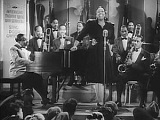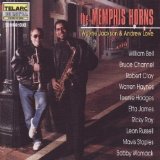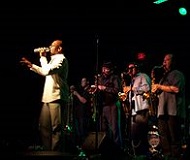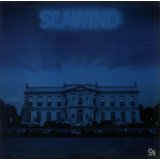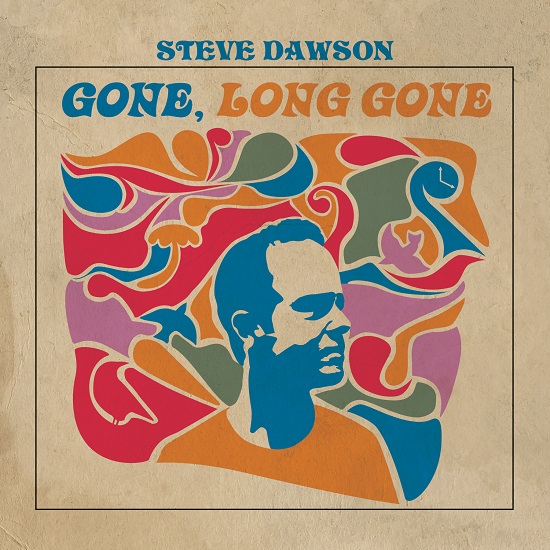
We’re still seeing and hearing albums created during the lockdown using remote technology; this one’s a bit different in that it’s the first of three albums recorded by Steve Dawson during the pandemic featuring songs that might otherwise never have been released. The ten songs on “Gone, Long Gone” reflect the eclectic nature of Steve Dawson’s work as a performer and producer. As a multi-instrumentalist and keen student of musical history, Steve brings a wide range of influences and musical knowledge to anything he does; his own album is no exception. Of the ten tracks, there are two contrasting instrumentals, showcasing Steve’s exceptional guitar skills, seven songs co-written with the brilliant Matt Patershuk, and one cover.
The cover is a song that everyone with any interest in music at all seems to love (apart from Rod Stewart, who apparently refused to sing on the Faces studio version of the song). Steve takes it at a very relaxed pace, building up to big harmonies in the chorus and showcase solos towards the end. It’s not quite as punchy as the original, but it’s an honest effort and a lovely homage. The two instrumentals demonstrate different facets of Steve’s work: his interest in Hawaiian music shines through “Kulaniapia Waltz”, creating an authentic feel with ukulele and steel guitar, plus the not-so-authentic pump organ while “Cicada Sanctuary” is a solo acoustic guitar piece inspired by hearing the noise of massed cicadas and being inspired to play something that fitted the mood. Both are very evocative mood pieces.
The remaining seven songs are the Matt Patershuk co-writes. Steve has always been wary of the collaboration process, but Matt’s a good friend and he’s a songwriter that knows how to write something that’s a bit different. The results are very impressive; “King Bennie had his Shit Together”, a fictionalised take on the life of Hawaiian steel guitarist King Bennie Nawahi, set against a backdrop of a jazzy bluegrass shuffle, tells an interesting story, cleverly pulling the listener into the first-person narrative of the tales of an old musician.
You can find historical musical references dotted throughout the album; the opener “Dimes” is a bit of fun that hints at Little Feat, “Bad Omen” and “6 Skeletons in a Car” (not as gruesome as it sounds) both have a brooding, menacing Southern groove feel while “I Just Get Lost” jumps into a chorus that strongly echoes The Beatles’ “Revolution”. You get the picture; there’s a lot of variety and you never quite know what’s round the next corner.
“Gone, Long Gone” is an album for people that want to actually listen to music, rather than passive consumers; the quality of the songwriting, playing and arrangement deserves much more than that. It’s out now on Black Hen Music (BHCD0096).
Here’s the official video for the album’s opener, “Dimes”:
 A producer, a photographer and two musicians walk into a pub. Sorry, there isn’t a punchline to this; it’s just what happened. A quick pre-Christmas beer with some music business friends to chew the fat; what do you think we talked about? As always with these semi-unplanned sessions something good came out of it. We’ll leave it to Graeme Wheatley, bass player and songwriter with the band Deep Blue Sea to tell the story, enhancing it with some music trivia. You might want to start this piece whenyou have about an hour to spare because it’s a bit addictive, especially after Riot Towers made a contribution,
A producer, a photographer and two musicians walk into a pub. Sorry, there isn’t a punchline to this; it’s just what happened. A quick pre-Christmas beer with some music business friends to chew the fat; what do you think we talked about? As always with these semi-unplanned sessions something good came out of it. We’ll leave it to Graeme Wheatley, bass player and songwriter with the band Deep Blue Sea to tell the story, enhancing it with some music trivia. You might want to start this piece whenyou have about an hour to spare because it’s a bit addictive, especially after Riot Towers made a contribution,
Sitting in The New Cross House pub the other night with Allan McKay (something that could very easily become habit forming), we were talking about his series of guest articles “High Fives” in Music Riot – sign up now if ya haven’t already!
I’ve written a few before and always like rambling on about whatever, so I was happy to quickly volunteer to write one for this Christmas – even before Allan gave me my first pressie of the year – even if I had no idea what to waffle on about.
We were with Iago Banet, a guitarist from a band that I’ve heard are not that bad and we were talking about a gig we did a few weeks ago. Our singer, Dre Smith, had lost her voice and we were doing the gig as a 3 piece – playing songs we’d never played before. I proudly boasted that I’d sang the entire lyric to “Blinded By The Light” by Brucie without a single rehearsal. Allan asked if I liked Manfred Mann’s version or the original best, then Iago reminded me that after 3 attempts we’d had to abandon “All Along The Watchtower” because I kept getting the first line wrong!!! Pride comes before…
Anyway, this conversation led to the topic of this High Five.
Five covers that I think are better than the original.
Only my opinion here – but when I got to thinking about it – there’s maybe 20 or 30 I could muse about. So, I thought I’d kick it off with two people who I consider to be un-betterable – but concede that in these two occasions, they are bettered.
Song 1
All Along The Watchtower – Bob Dylan – Jimi Hendrix
OK, if you know me at all, you may have heard me at sometime mention the name Bob Dylan. He’s the cat, the verbal acrobat-tery, the lyrical dexterity and temerity in all sincerity. A couple of weeks ago we were playing Bude R&B Festival, which involved a good 4 hour drive back and forth. Amanda Dal, our wonderful drummer, asked me, unprompted, to play the three albums Bob recorded in 1965 that “invented Rock Music as we know it”. Much to Iago’s horror. So we had a great journey back and forth listening to Bob. It’s Amanda’s turn next, so I am going to get 4 hours of singer songwriter LP. The fact that she’s a ringer for Bob makes me favourable disposed to her from the get go – so – I’m ok with this!
Anyway, some people say (fools that they are) that any cover of a Bob song is going to be better than Bob’s version. BUT THEY ARE WRONG!!!! This has only ever happened once in the whole wide universe since the beginning of time. And only one person could a done it. Jimi. Y’know, I’d love to be able to wipe the tape and hear Jimi’s version of Watchtower again for the first time. Can you remember that moment? I can’t. But listen to it now. The swagger, the invention, the sass, the sheer coolness. Four minutes of perfect cool. If Jimi hadn’t recorded it, would we remember the original? Was it just a fairly average track on a subdued and pared back album from Bob who might have been wondering at the time where he was going next. Recorded in 1967 after the “fall” it was a total turn away from the more blues inspired electric albums and a return to his more folkie side, but Jimi took this track, rocked it up, funked it up and delivery to my mind one of the greatest little guitar pop songs of all time.
Oh, BTW, the title of Bob’s album, John Wesley Harding. It was named after a Texan outlaw of that name – only they spelled it wrong!!! He was called John Wesley Hardin.
Compare and contrast:
Song 2
Nothing Compares 2U – Prince – Sinead O’Connor
I was a big Prince fan. Still miss the guy. He might have had demons and might have been just a tad obsessed but look at the catalogue of pop songs. Inventive, fun, joyous, rude, rock and raunch and lovesexy. He made pop a bit dangerous, a lot of fun and a lot of cool – combined a bit of Jimi, a bit of Marc, a bit of James Brown and a lot of genius. Until Sinead covered this song I would not have thought anyone could touch the little chap at his own game. I kinda thought Prince songs were indelibly stamped with Prince’s logo. You can’t touch this….
I wuz wrong. The frailty and fragile nature of the song fits Sinead and both somehow meld. She is the song, the song is her. That just doesn’t happen very often – if at all. That revolting phrase “you owned it” churned out on brain dead TV talent shows ad nauseam for once applies. You can’t think of the song without thinking of Sinead and vice versa. They might be so entwined that it overshadows her career.
OK, that’s two down and just to sum them up, nobody else has done a cover of a Prince song better than Prince and ditto Bob. Argue away, I’m not listening.
Compare and contrast:
Song 3
With A Little Help From My Friends – The Beatles – Joe Cocker
This is weird. The Beatles FFS? The greatest band ever. The greatest song writing partnership of the 20th century. The band that wrote the book (and the sequel). Have you heard some of the covers? “Hey Jude, Hey Bing”? Trust me, it was an album. My dad had it. Can you imagine the scene in our house? He was a jazz musician and I think he made this one attempt to be down with his son. He’d spent some futile time trying to tell me that all of this pop music stuff was nonsense and real music would eventually come into its own and Benny Goodman, Duke Ellington et al would be on Top of the Pops (Pops in this case being hep cat chat for Dads). Suffice to say most covers are cheesy in the extreme or just for shock value with nothing of value added. From Matt Monroe to Siouxsie Sioux. But, Joe? That voice. That presence. That simple honesty and stripped back truth. It’s a song, dare I say, that Paul didn’t really think was the Dog’s Bs so he suggested that Ringo sang it as a little bit of fun “What would you do if I sang out of tune?” and the whimsy fitted the feel of Sgt Peppers. But it was far from a stand-out track.
Now, fast forward a mere year or so. On stage at Woodstock and Joe says “the title of this song says it all”. The song is imbued with something more. A part of the hippy dream is captured in the performance. It’s a time piece. Oh and that voice? Come on. Just go have a listen. Band ain’t too bad either.
Song 4
Respect – Otis Redding – Aretha Franklin
Like Joe, this cover takes the song into places the original didn’t. Like the others too I guess. But with this one, you start pretty high up – with that voice, Otis. A voice that can quite easily make you cry. My Girl? Try A Little Tenderness? I Been Loving You Too Long? I’m tearing up now. And I’m a tough guy…
But Aretha takes a lyric that just might veer towards a bit misogynistic these days – y’know, man works all day – comes home to little lady cooking for him and expects a bit of R – E – S – P – E – C – T – and she makes it the first bona fide feminist mega hit defining moment of the decade. Oh yeah, and it was her major first hit after 10 years fighting against “the man”!!
What Aretha did changed the world. A cover version of a pop song changed the world? Yes, that’s what I said. Made a massive difference to the feminist movement and the civil rights movement. The impact of this little pop song can’t be ignored. That’s how deep my love is.
Oh, BTW, Otis didn’t really like the cover – but learned to live with it when the dosh rolled in – and also – listen to his version – most people think the lyric “R – E – S – P – E – C – T find out what it means to me” is part of the original.
Song 5
Girls Just Wanna Have Fun – Robert Hazard – Cyndi Lauper
For years I’d thought Prince wrote this especially for Cyndi. Someone told me some Fake News and I never questioned it. It’s a great song and it seemed believable. It’s my wife’s favourite “getting ready for Friday Night” song – so I had to include it for her.
There’s not a great deal to say about it other than, in Cyndi’s hands and voice, it’s perfect pop. In Robert Hazards? Well, have a listen to the song below. My main question is, How did Cyndi hear this very very average song and say “I can make this song a mega hit that will last generations and become Graeme’s wifes’ favourite “getting ready for Friday Night song” for all time”? I dunno the answer but one thing I will point out is, the song lasts 2 minutes and 30 seconds and the actual track lasts 4 minutes and 30 seconds. And by strange coincidence, when my wife says she’ll be ready in 15 minutes… you can fill in the rest.
Just before I trot off to have a mince pie, there were a couple of things I considered but rejected and hopefully some of these will incite you to invective 🙂
- Leonard Cohen covers – it’s easy to say other people sing them better than Lenny. That’s not the point. We can all say a photograph of a tree looks more like a tree than a Van Gogh painting of a tree. I don’t know where I’m going with that – other than Lenny is the Van Gogh of pop – funny, sad, dark, deep, tortured and Chaplinesque – there’s a crack in everything – that’s how Lenny gets in. I like his cracks. In his house there are many flaws – all of them interesting.
- Led Zeppelin – when you actually claim to have written all your covers yourselves – it doesn’t apply.
- Anyone covering Tom Waits with a gravelly voice – don’t be silly (Sir Rodney).
- Anyone covering Tom Waits with a lovely voice – as above.
- The Blues – it’s totally impossible to compare Crossroads – Robert Johnson to Cream. Both are wonderful in their own way – and I bet you can think of lots more examples. So, off you go, your challenge is now to name 5 blues songs that have brilliant originals and brilliant – but significantly different – covers.
Many thanks to Allan for allowing me to stop work for 3 hours to write this 🙂
Have yourselves a merry little Christmas, if the fates allow.
Cheers
Graeme
Written before the election December 2019 (I might not be in such a frivolous mood after that).
Sorry Graeme, but we need to have the last word here (not about the election, not even going there), especially after squeezing in two High Fives in one piece, but we did mention another song, which was a band covering their own song. Thin Lizzy’s “Nightlife” version of “Still In Love With You” should have pushed all the buttons as a duet between Phil Lynott and the wonderful Frankie Miller, but it was a bit of a mid-tempo plodder. Someone obviously worked out that it was a potential anthem, slowed it down, stuck a truly wonderful Brian Robertson solo in there and, voila, rock classic.
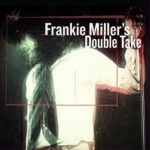 The promotion campaign for “Double Take” features some of the artists involved (Rod Stewart, Paul Carrack and Huey Lewis) talking about the first time they saw Frankie Miller. Now, that’s a great idea.
The promotion campaign for “Double Take” features some of the artists involved (Rod Stewart, Paul Carrack and Huey Lewis) talking about the first time they saw Frankie Miller. Now, that’s a great idea.
Freshers’ Week, Dundee University, 1976 and the first gig of the year was Frankie Miller’s Full House. I went to the gig with my new mate Steve (still a mate and writing great reviews for MusicRiot). The band were superb and we left the gig raving about Ray Minhinnet’s guitar work, Chrissy Stewart’s bass playing, but most of all about Frankie’s stunning soul voice. He started the ballad “With You in Mind” a cappella, and with perfect pitch, before the band dropped in underneath the vocal; I was completely hooked from that moment. I’ve seen an awful lot of gigs since then, but I’ve never heard a band that nailed it so completely, song after song.
So let me put “Double Take” into some kind of personal and historical context. As Frankie slowly fought back from the brink after a brain haemorrhage in 1994, you would hear occasionally from friends on the Scottish music scene about his progress; not frequently, but often enough to know that things were gradually improving, and it carried on like that until 2012 when word started to leak out that a project with Frankie’s old demo tapes was in progress. It’s taken over four years and probably a few unexpected twists and turns, but the final result is “Double Take”, nineteen unreleased Frankie Miller originals reconstructed from demo vocals, and all but one reimagined as duets with singers that wanted to be involved with the project. Although Frankie’s biggest chart hits (“When I’m Away From You” aside) were interpretations of other people’s songs, he also wrote a shedload of great songs for himself and other artists.
The nineteen songs on “Double Take” are pretty representative of Frankie’s songwriting output, covering soul, blues, rock, country and ballads. And that’s the staple diet of Scotland, right there; forget your deep fried Mars Bars. All of the songs have been arranged around the original demo vocals (with Frankie involved in quality control), but the quality of the voice is so good that almost everything sounds like a full-scale production. To be honest, given the choice, I’d rather listen to Frankie Miller demos than most singers’ finished product.
The guests on “Double Take” are a mix of megastars and people that Frankie knew and worked with in the past. Without listing the whole lot, how about Joe Walsh, Elton John, Kid Rock, Delbert McClinton, Kim Carnes and Willie Nelson. Add those to the ones listed at the top of the article and you’ve got a huge amount of respect across musical styles for Frankie’s work. Great news for fans of Frankie from the mid-seventies is that Full House appear on three songs in the middle of the album. “When It’s Rockin’” (with Steve Dickinson) is a horn-driven rocker, “Beginner at the Blues” (with Delbert McClinton) is a slow blues and “To Be With you Again” (with Kim Carnes) is a mid-tempo ballad. For a while there, I was back in that night in1976.
With so many songs and such a variety of arrangements, it’s difficult to pick standouts, but the gospel choir of “Where Do the Guilty Go” (with Elton John) and the country ballad “I Want to Spend My Life with You” (with Willie Nelson) are hard to beat, while the hauntingly simple “I Do”, with only Frankie’s vocal over a sparse arrangement is the perfect closer for the album.
This has been a long journey for some very dedicated people, culminating in an album that can only add to Frankie Miller’s legacy by bringing those powerful vocal performances to a wider audience and unearthing so many unreleased songs. This is a classic.
“Double Take” is out on September 30th on Universal.
Here’s a sneaky little peek for you:
Our next contributor plays saxophone with Southside Johnny and The Asbury Jukes but also released a strikingly good album this year as part of the New York Horns which is one of Allan’s albums of the year. When we asked him for a High Fives piece, here’s what he came up with. We think you’ll like this.
5 Horn Sections That Changed My Life
As a saxophone player, one of my absolute favorite ways to make music is with other horn players. Give me a trumpet or two, a couple of other saxophone players and a trombone to add some love, and you’ve got a recipe for a whole lotta fun. If the rhythm section is the meat and potatoes, and the vocalist is dessert, then the horn section is the salt. We bring out all the other flavors and make everything oh so much sweeter.
In thinking about the subject matter for this best-of list, it quickly dawned on me that I had MANY more than five examples that I could draw upon to make my point. So many that I almost gave up! After some careful consideration though, here’s five of the horn sections that have changed my life through their contributions to the music:
THE swingin-est band in the history of jazz. Count Basie’s band emerged in the 1930’s in Kansas City, and became the de facto definition of foot-stomping swing with their penchant for shouting blues, riffing head arrangements, and an infectious groove that just made you want to dance. The jazz traditions of “riffing” and “head arrangements”, while not originating with the Basie band, were certainly developed and forwarded onward by the band. Many of the riffs, licks and phrases that you will hear modern horn sections play can trace some or part of their lineage back to the Basie band. Check out “The Atomic Mr. Basie” (1957) and “Count Basie Swings, Joe Williams Sings” (1956). Two of my all time favorite Basie albums.
James Brown redefined popular music. He also redefined the role of the horn section in popular music. Prior to his influence, horns would generally have a more melodic role – playing melodies and generally being in a “lead” role. The late swing and early jump blues bands often were led by horn players and under the vocals the horns played a large supporting role, remaining a mostly harmonic underpinning. James changed all that. The horn section under James Brown became another rhythmic instrument, driving and propelling the groove. With snapping rhythmic pulses and repeating motifs, the horn section was another texture in the rhythm section, adding propulsion and rhythmic intensity. Check out “Mother Popcorn”, “Super Bad”, “Soul Power” and “Cold Sweat” for classic examples. The JB Horns (Maceo Parker, Fred Wesley, Alfred “Pee Wee” Ellis) also were a fixture of P-Funk and Bootsie’s (Collins) Rubber Band, as the Horny Horns.
Growing up in North Carolina, in the southern United States, it was inevitable that I was exposed to the music coming out of Memphis, Tennessee and especially STAX Records. Wayne Jackson and Andrew Love, aka the Memphis Horns, are one of the most recorded horn sections in history. If you’ve heard “Dock Of The Bay”, “Soul Man”, “Hold On I’m Comin’”, “Suspicious Minds”, “Sweet Caroline”, “Takin’ It To The Streets”, “Let’s Stay Together”, “Born Under A Bad Sign”, “Knock On Wood” (and countless other hits), then you’ve heard the Memphis Horns. They appeared on virtually every STAX recording, backing Otis Redding, Sam & Dave, Eddie Floyd, Carla & Rufus Thomas and an endless list of others. Not only were they a staple of the Memphis scene but could also be found as part of the Muscle Shoals scene, and on recordings with Aretha Franklin and Wilson Pickett.
No modern horn player that plays funk, soul or R&B hasn’t heard of or spent time studying TOP. Bursting onto the scene in Oakland, CA in 1968, Tower saw its peak success from 1973 to 1974. The band continues to tour extensively to this day, playing hundreds of shows every year across the world. The horn section has been featured on countless recordings by artists as diverse as Little Feat, Graham Central Station, The Monkees, Santana, Elton John, John Lee Hooker, Rufus, Rod Stewart, Huey Lewis and the News, and Aerosmith and has come to define a punchy, modern and funky style of writing and performing for horns. Check out “Tower of Power” (1973) and “Back to Oakland” (1974) for the definitive TOP experience.
While not a horn section unto himself, Jerry Hey has probably written more horn arrangements for hit songs and albums than anyone else in the business. As part of the Seawind Horns, Jerry was brought to the attention of Quincy Jones. That relationship led to Jerry’s writing for some of the biggest names in the industry. His credits as an arranger include albums from Michael Jackson, Brothers Johnson, Donna Summer, Rufus, George Benson, Patti Austin, James Ingram, Frank Sinatra, Barbra Streisand, Earth, Wind and Fire , Al Jarreau, Chaka Khan, and the list goes on… Two of my favorite albums that feature Jerry’s writing (and the Jerry Hey Horns) extensively are Al Jarreau’s “Jarreau” and “High Crime” (Check out “Imagination”!) and likely my all time favorite Jerry Hey arrangement (and performance) is from Michael Jackson’s “Workin’ Day And Night” (“Off The Wall”).
I could go on and on… there are so many great horn sections, players and writers out there, making incredible music. Hopefully this list will give you some food for thought and a good place to begin to explore the horn section legacy. Enjoy!
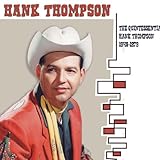 Normally, Closet Classics would feature an album but I think this song deserves its own CC feature. “The Wild Side of Life” is a classic country song, which alienates most of the music snobs instantly. It’s great to see that country has finally become accessible, songwriters in the UK are admitting to being influenced by it and it’s hard to believe now that for decades the genre was seen as a bad joke.
Normally, Closet Classics would feature an album but I think this song deserves its own CC feature. “The Wild Side of Life” is a classic country song, which alienates most of the music snobs instantly. It’s great to see that country has finally become accessible, songwriters in the UK are admitting to being influenced by it and it’s hard to believe now that for decades the genre was seen as a bad joke.
This song played a huge part in my childhood. Country music has always been popular in Scotland. I’ve got a few theories about that, but I’m sure the sociologists and musicologists can give you much better-researched explanations; here’s a personal perspective.
In 60s and 70s Scotland there was a great tradition of families and friends gathering (usually after the pubs closed, which was 10 o’clock in those days) to sing songs and tell jokes, and maybe have a wee dram or two. Most of the songs were country: “Crying Time”, “Please Help Me I’m Falling”, “From a Jack to a King”, “He’ll Have to Go” and the occasional standard like “Summertime”. Everyone had their own song which they performed at every session. I’m guessing that they picked up those songs from American Forces Network (AFN) radio, American military bases and artists playing in working men’s and ex-servicemen’s clubs. However they did it, they learned those songs and passed them on in the age-old oral tradition. A lot of those songs made it on to the club circuit because you didn’t have to be a great guitar player to do passable job of supporting your voice with a few chords on an acoustic guitar to sell a good song; depending on your vocal range, you could get by with C, F and G at a push. Some combinations of those letters might have even helped you with hecklers.
So why “The Wild Side of Life”? Really simple, it was one of my grandad’s songs and he could really sing (and he fought in a world war, got shot, went to New York, and won a Fife Junior Cup football medal as well); when you grow up hearing a great song delivered with feeling by someone with a good voice, then it’s going to stick for life. And you’ve probably guessed that there was a bit of hero-worship in there as well. So the song was stuck in my consciousness and it wasn’t going away and, although the early 70s seemed to be a country-free zone on the surface (apart from the schlock that made the UK charts), my favourite singers and songwriters (Neil Young and Jackson Browne, for example) were heavily influenced by country singers; Neil Young even covered “Oh, Lonesome Me”. Towards the end of the 70s, it became acceptable to like “The Wild Side of Life” when it was covered by such rock tastemakers as Status Quo and Rod Stewart, but I was there way before all of those denim boys and feather cut fancy dans because I loved the original.
The classic version of the song, for me anyway, is the 1952 version by Hank Thompson, whose plaintive vocal perfectly matches the theme of loss in the song, but there are dozens of others by country artists before you even start to look at pop covers. The song even generated one of the earliest answer songs in Kitty Wells’ “Wasn’t God Who Made Honky Tonk Angels”, which was also a No. 1 in 1952. As the 70s morphed into the 80s, more country acts crossed over into the mainstream and artists like Carlene Carter, Rodney Crowell and Rosanne Cash along with the bad boys like Willie Nelson and Merle Haggard. Even angry young man Elvis Costello did an album of country covers and it was ok to admit that you always loved country music.
That should have been the end of the story, but there was still another twist. When I moved to London and worked with people whose parents came to the UK from the Caribbean, I discovered that they grew up listening to the same music that I had listened to as a kid in a Fife mining village. Now, that was a weird sensation; discovering a completely unsuspected common musical heritage with friends from a completely different background and maybe that says something about music being able to break down all sorts of barriers. Of course, the whole idea of country being big in the Caribbean in the 50s is old news now that Trevor Nelson has spoken about it, but it came as quite a shock at the time.
As for the song, well, whenever I pick up a guitar and start playing, it usually manages to poke its head in there and it’s a challenge to try to find a musical style you can’t fit it into. And it’s such a great song that it can make a mediocre player and singer sound reasonable. What more do you want?


